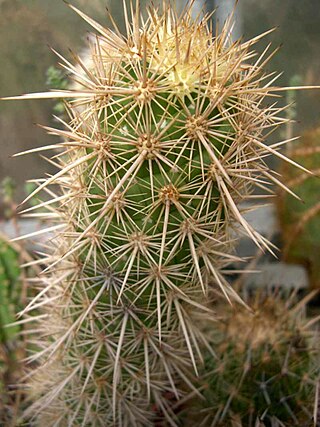
Stetsonia coryne, the toothpick cactus, is the sole species in the cactus genus Stetsonia. Stetsonia coryne is native to arid regions of South America, where it grows to a height of 15 to 25 ft tall. It contains mescaline and other alkaloids.
Cochemiea angelensis is a species of plant in the family Cactaceae.

Cochemiea tetrancistra is a species of fishhook cactus known by the common name common fishhook cactus. It is native to the Mojave and Sonoran Deserts of northern Mexico and the southwestern United States, where it grows in a variety of desert habitat types.

Cochemiea multidigitata is a species of flowering plant in the family Cactaceae that is endemic to San Pedro Nolasco Island in Mexico, growing on steep slopes. Cochemiea multidigitata sprouts a white to cream-colored flower from spring to early summer.

Ferocactus pilosus, also known as Mexican lime cactus or Mexican fire barrel, is a species of cactus in North America.

Oreocereus celsianus, or the old man of the mountain is a member of the family Cactaceae native to the high lands of the Andes in South America, and is named for its fluffy white hair, which may protect it from intense sunlight and extreme temperatures.

Ferocactus pottsii is a species of Ferocactus from Mexico. The specific epithet has also been spelt pottsi.

Ferocactus haematacanthus is a species of Ferocactus from Mexico.

Matucana haynii is a species of Matucana found in Peru.

Cochemiea blossfeldiana is a species of Cochemiea found in Mexico.

Cochemiea insularis is a species of Cochemiea found in Mexico.

Cochemiea capensis is a species of Cochemiea found in Mexico.

Cochemiea armillata is a species of Cochemiea found in Mexico.
Cochemiea cerralboa is a species of Cochemiea found in Mexico.
Cochemiea estebanensis is a species of Cochemiea found in Mexico.

Cochemiea halei is a species of Cochemiea found in Mexico.
Cochemiea pondii is a species of Cochemiea found in Mexico.

Cochemiea phitauiana is a species of Cochemiea found in Mexico.

Cochemiea palmeri is a species of Cochemiea found in Mexico.

Echinocereus maritimus is a species of cactus native to Mexico.
















